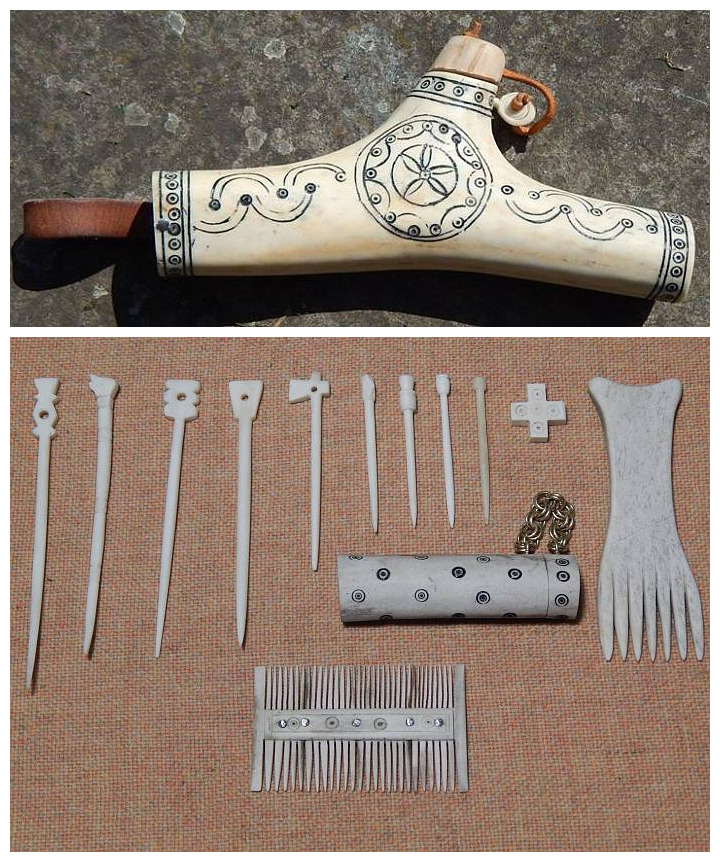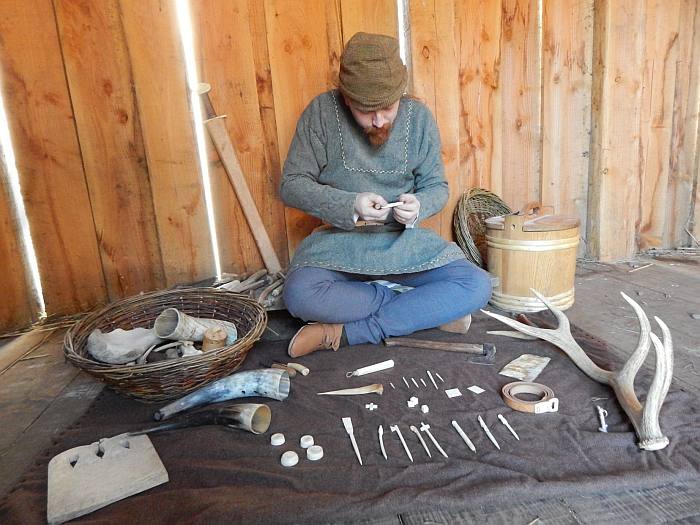David Constantine gave the FBDMA autumn lecture on Friday 4th November 2016 in the Parish Centre, Berwick-upon-Tweed. He spoke on “Bone and Antler in History and Archaeology”, examining what can be learned about the past from the study of animal archaeological remains, and he brought with him a large assortment of artefacts and archaeological examples to illustrate his talk. A summary of his talk appears below.
David is seen below at work as a bone craftsman.
FBDMA Autumn Lecture 2016
On Friday 4th November 2016, the FBDMA welcomed David Constantine to the Parish Centre in Berwick for the Annual Autumn Lecture. David is a researcher and practitioner in Medieval Archaeology, specialising in the early Medieval, Viking and Saxon periods.
He explained that bones can tell so much about the past including environmental changes, so that the timescale of the ruin of a building can be estimated via the ‘floor’ of small mammal bones, deposited in the pellets of the particular species of owl which roosted and died there, the roof timbers rotted and finally collapsed. The midden of a Roman Fort contained bones of mainly pork and beef, the remains from the kitchens; but the drains from the latrines contained small lamb bones and chicken wing-bones, snacks eaten while ‘taking a comfort break’! Animal bones can show healed trauma after accidents, or when a domestic animal has been treated, also damage caused by disease such as arthritis which apart from the initial trauma, can cause secondary problems due to additional stress on unaffected joints. Sheep were kept mainly for wool and milk and would be retained until they died a natural death. Bones were a valuable commodity, bone-workers and tanneries were often found close to butchers’ establishments, the long bones of the forelegs and the hoofs being especially useful. During the Saxon period there were no ‘standards’ and all shapes and sizes of tool can be found. Nearer the coast where whale bone was plentiful, it is so oily it would burn like wood, and some items which have no apparent use must have been symbolic or simply for adornment.
Animal bone cannot exceed its natural size but fish can continue to grow bone, depending on the food supply, so that age can be estimated by the number of ‘rings’ as in the growth of a tree. Large fish bones from the Mesolithic in Western Scotland suggested that quite long sea voyages were undertaken to obtain the bigger fish.
Finds of reindeer antler, claws of bears and wolves are occasionally found in contexts outside their normal range which are probably from skins imported from Scandinavia.
Antler was even more valuable, being three or four times stronger than bone. The majority of combs of various types found on Orkney were made of antler, and earlier Pictish combs were made from Viking antler. Combs were found at Bamburgh, but there was no evidence of a workshop, suggesting that there was trade from the Baltic region. For full strength (surpassed only by metal) antlers must be shed not cut, suggesting trade with hunters and keepers. Many antler tools have been discovered on prehistoric sites such as Stonehenge. Cow and sheep horn is comparatively small and degrades quickly, but when heated becomes very plastic and after soaking can be flattened, making it useful for small window panes and lanterns, sometimes referred to as ‘lanthorns’.
This was a most interesting and informative talk and the examples of bones and associated artifacts were keenly examined with a number of questions.
Posted in Events
Categories
Archives
- July 2024
- May 2024
- March 2024
- February 2024
- December 2023
- November 2023
- October 2023
- September 2023
- June 2023
- May 2023
- April 2023
- March 2023
- February 2023
- November 2022
- October 2022
- September 2022
- May 2022
- April 2022
- March 2022
- February 2022
- December 2021
- October 2021
- September 2021
- August 2021
- July 2021
- June 2021
- May 2021
- April 2021
- February 2021
- January 2021
- December 2020
- November 2020
- October 2020
- September 2020
- June 2020
- April 2020
- March 2020
- February 2020
- January 2020
- November 2019
- September 2019
- June 2019
- May 2019
- April 2019
- March 2019
- February 2019
- January 2019
- December 2018
- November 2018
- October 2018
- September 2018
- August 2018
- June 2018
- April 2018
- March 2018
- February 2018
- January 2018
- November 2017
- October 2017
- September 2017
- August 2017
- July 2017
- June 2017
- May 2017
- April 2017
- March 2017
- February 2017
- January 2017
- November 2016
- October 2016
- September 2016
- August 2016
- June 2016
- May 2016
- April 2016
- March 2016
- February 2016
- January 2016


